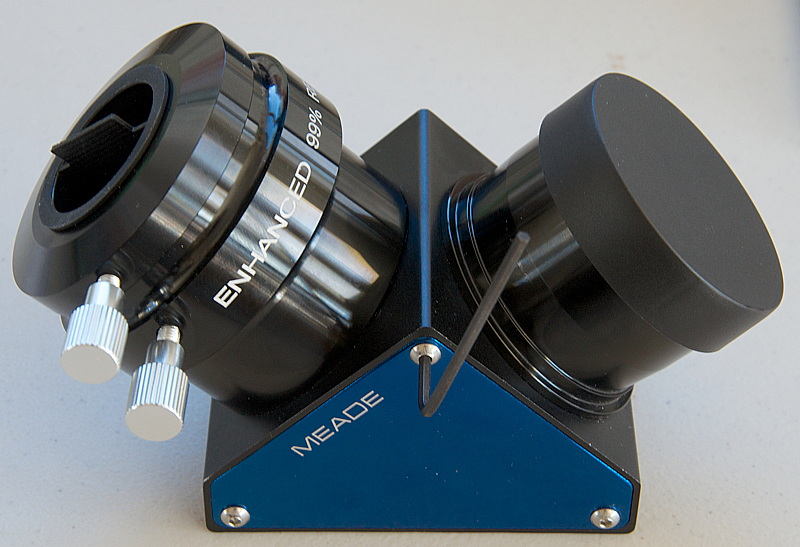
Meade Diagonal Status, Project Nightflight,
Jupiter Moons, Supernova SN2014j
Posted: 28 January 2014
On my previous report I mentioned that a problem has developed with my Meade 99% Reflectivity Mirror Diagonal. Since the diagonal was purchased less than a year ago and still under warranty, I sent this inquiry to the place of purchase (Woodland Hills Camera & Telescopes):
re: Order #10000xxxx
March 30, 2013
The eyepiece holder tube on my Meade - 99% Reflectivity Mirror Diagonal has come loose from the diagonal box. The diagonal is less than a year old and still covered under warranty. I have photos showing the problem if you want to see them. I'd like to get the diagonal replaced. Thank you.
The tube rattles when the diagonal is moved around. These are the photos that show the gap that appears when the tube moves out of position:


The dealer forwarded my inquiry to Meade. A little later, I received a call from José at Meade. He advised that I should be able to fix the problem by removing the blue covers on both sides of the diagonal and tightening four setscrews holding the eyepiece tube. I removed the covers on both sides by unscrewing the three screws on both sides:

This photo shows the two setscrews on one side (two others on the other side):

Unfortunately, I was unable to tighten these setscrews. I tried several sizes of hex keys, all the way down to 0.05, but none worked. Also tried some small flathead and Torx heads. I could not see any screw heads inside the very small holes. Meade has agreed to replace the diagonal, but unfortunately it is currently on backorder, possibly for two weeks. I'll report when I receive the replacement.
|
Opened: Monday, 27 January 2014, 1805 MST Temperature: 67°F |
Session: 651 Conditions: Clouds W-NW-N-NE |
I received this knit cap from Project Nightflight, located in Austria:

I will proudly wear it in Cassiopeia Observatory:

Thanks to Erwin Matys and the Team at Project Nightflight! Check out their web site for more information.
1812 MST: viewed Mercury, 83X. Bright, with no clouds hampering the view. But clouds elsewhere in the sky would become a problem. Switched to 222X, but seeing was not good enough to get a good view of Mercury's phase.
By 1820 MST, clouds were in much of the sky. 1821 MST: viewed Jupiter, 222X. Seeing was not good, but the four Galilean Moons were visible. Took this handheld afocal 222X photo (cropped) of Jupiter's moons using the iPhone 5s (Jupiter is overexposed) at 1833 MST:

Here are the names of the four moons and their positions from the Pocket Universe iOS app:

1839 MST: clouds were now thicker in the north, just where I wanted to view the M82 galaxy and its supernova SN2014j. Slewed to M82 and at 1845 MST, viewed it and the supernova through some thin clouds using 83X. The supernova was very obvious. The view was short-lived however, and at 1855 MST, M82 was hidden by clouds.
1907 MST: clouds were getting thicker and covering most of the sky. I was able to get another look at M82 and SN2014j through a small hole in the clouds.
1920 MST: checked the latest satellite image; more clouds coming from the northwest. Decided to end the session.
|
Closed: Monday, 27 January 2014, 1933 MST Temperature: 51°F |
|
Comments are welcome using Email. Thanks.
Cassiopeia Observatory Home Page